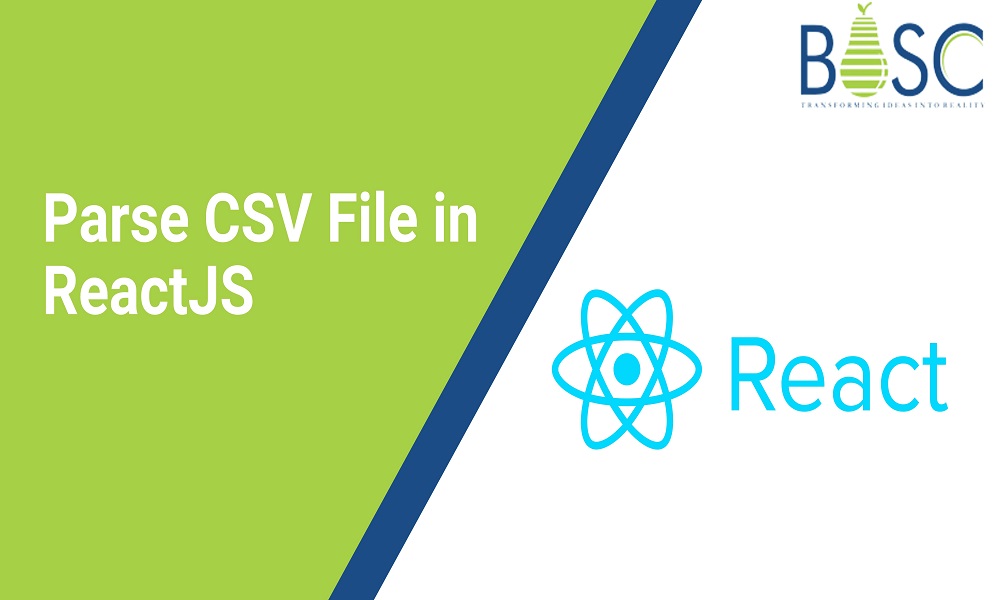People prepare CSV files for different types of documentation and transfer them between devices. However, it is not simple to extract data directly from these files. In this case, users have to handle the full parsing process to access and view the data in CSV files properly.
Hire React Developers from the leading app development company that utilize the solutions and commands that are related to the React framework to handle the parsing steps. It is possible to use various packages available with React.js that can read the files, but most of them do not accept the same for CSV files. Therefore, specific steps should work to enable this functionality.
What is React?
Before discussing how the parsing process is possible, let’s first understand the React framework. It is a type of JavaScript-based library that Facebook created to develop user interfaces.
It introduces virtual DOM as a usable process and showcases the best side of DOM manipulation, unlike many other currently active frameworks. Typically, programmers utilize this solution and the related languages and APIs for single-page app development.
To note, the best features that the React.js framework supports are:
- One-sided data flow
- High-quality performance
- Component-based
Also Read: Top 10 Most Used React Component Libraries in 2022
What is Papa Parse?
Regarding how to read and parse the CSV file types with React.js, the developers would have the most success with the package name Papa Parse. This robust and dynamic in-browser JavaScript-based CSV parser assures precise and fast performance with this extraction level.
The Papa Parse package has a straightforward syntax that allows for high-quality CSV file parsing. After that, the algorithms working here read the data in JSON format when using this process. So, in essence, utilizing this parser solution makes the process straightforward and highly efficient.
Using the papa parser, the handleParse function will parse the CSV data and set the data state to the columns of the CSV file. The lifecycle of React component that includes an input element to accept the uploaded file, a button to parse the data upon click, and a container to display any errors or processed data is then eventually returned.
Example
<ReactFileReader handleFiles={this.handleFiles} fileTypes={'.csv'}> <button className='btn'>Upload</button> </ReactFileReader> handleFiles = files => { letreader = new FileReader(); reader.onload = (e) => { // Use reader.result alert(reader.result) } reader.readAsText(files[0]); }
Notable Features of Papa Parse
There are specific features available in the papa parse package that coders find useful while working with it. They are as follows:
- The package is extremely simple to utilize.
- It is possible for one to stream large files with this package.
- It has type support.
- No dependencies are needed to operate with this.
- The package can efficiently handle quotations and line breaks.
- It supports auto-detect delimiter.
How to Efficiently Parse CSV Files with React?
Programmers follow specific steps using the Papa Parse package to handle the CSV File parsing process. They are explained hereafter.
Step 1: Open a new project
Firstly, you must prepare a new project for the React framework to allow the papa parse solution to work properly. To prepare a new React project, you have to add and run the given command:
npx create-react-app myproject
Step 2: Install the package
After setting up the project, you have to install the papa parse package. For this, you have to add the next command and run it:
npm install papaparse
Step 3: Focus on the project structure
Next, you must focus mainly on the project structure you are working with. Typically, the best React Developer centers on the “src/App.js” file. To begin this process, you must clean the React boilerplate component to make it simpler to handle.
For this, one has to develop the first input component that one can use to input their CSV file. Then, it is vital to check that the file format is indeed CSV to proceed with the next steps. In case it is not a CSV file, you will see the error state prompt.
Step 4: Continue with the parsing process
Finally, the user working on this app development process has to utilize the papa parser to parse the content in the uploaded CSV file. All column names automatically appear on the browser. Here is an example code of how this type of sequence will go.
import "./App.css";
import { useState } from "react";
import Papa from "papaparse";
function App() {
const [parsedData, setParsedData] = useState([]);
const [tableRows, setTableRows] = useState([]);
const [values, setValues] = useState([]);
const changeHandler = (event) => { Papa.parse(event.target.files[0], { header: true, skipEmptyLines: true, complete: function (results) { const rowsArray = []; const valuesArray = []; results.data.forEach((d) => { rowsArray.push(Object.keys(d)); valuesArray.push(Object.values(d)); }); setParsedData(results.data); setTableRows(rowsArray[0]); setValues(valuesArray); }, }); };
return (
<div>
<input
type="file"
name="file"
onChange={changeHandler}
accept=".csv"
style={{ display: "block", margin: "10px auto" }}
/>
<table>
<thead>
<tr>
{tableRows.map((rows, index) => {
return <th key={index}>{rows}</th>;
})}
</tr>
</thead>
<tbody>
{values.map((value, index) => {
return (
<tr key={index}>
{value.map((val, i) => {
return <td key={i}>{val}</td>;
})}
</tr>
);
})}
</tbody>
</table>
</div>
);
}
export default App;
Step 5: Run the app
Finally, you are ready to enable the steady running of the app. For this, you have to access the terminal and add the given command:
npm start


Conclusion
Indeed, with the solutions and steps mentioned, it is possible to safely and effectively parse CSV files using React.js. Follow the processes mentioned carefully to ensure no error with the extraction method. Or, for satisfactory results, contact the best React app development company.
They have experience handling different procedures, including how to parse CSV file types and much more securely. So, reach out soon!
If you want to know more about the React framework, you can go through our blogs.
Frequently Asked Questions (FAQs)
1. Why use JSON parse in ReactJs?
If you want to use the JSON data along with its key, then the parse() function is utilized. A parse() function will take an argument of JSON source and transfer it to JSON format. However, data is often fetched from the server, and the response format is a string.
2. Is it possible to parse a CSV file in React JS?
A HandleParse function will parse CSV data, use the papa parser, and set the data state to the columns of CSV files. Hence, it will return the component that consists of an input element to take an uploaded file, a button to parse data on click, and the container to view errors or the parsed data.
3. How can we read CSV files in JavaScript?
To convert or parse CSV data into the array, we require JavaScript’s FileReader class, which has a method called readAsText() that will read the CSV file content and parse results as a string text. If we have the string, we will make the custom function to turn the string into an array.
Book your appointment now




